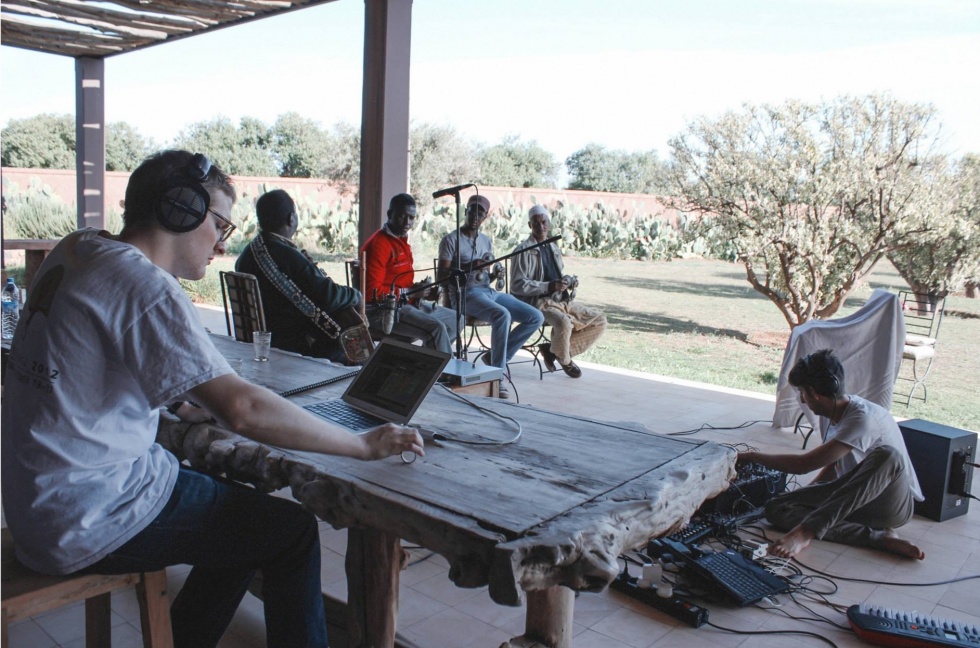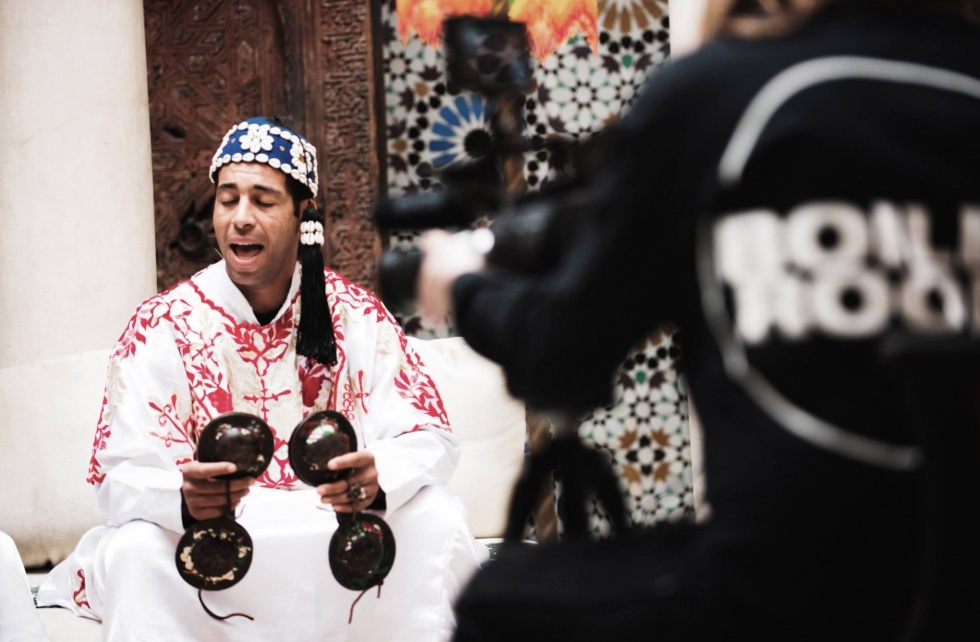Editor’s Note: On Sunday 2nd August we were informed about the sad passing of Mahmoud Guinia, age 64.
Given the cherished week a handful of us at Boiler Room spent in Marrakech immersed within Gnawa – the contemporary form of which Maâlem Mahmoud Guinia is widely considered the ‘Godfather’ – this hit especially hard. Alongside a handful of records littered across the past decades, the footage we recorded is perhaps the highest-quality documentation of Gnawa available. Given the circumstances, that’s a peculiar feeling to stomach, but we at Boiler Room feel immensely grateful to have been so closely involved with it, if only for a brief moment.
(The trip can be relived in our written editorial, mini-doc and archived recordings – all housed below.)
When we worked with the Maâlem last March, he was in robust spirits; any poor health was well masked. But he may have known. Guinia bequeathed his guembri to his son during his last public performance at the Gnawa World Music festival this June – a symbolic act, not just for Guinia accepting the severity of his illness with quiet dignity, but also for the wider implications of centuries-old heritage and lineage within the culture.
More important though is the loss of a beloved musician and great man. Our thoughts are with his family and friends at this time.
Rest In Peace.
– – –
“The most important single element of Morocco’s folk culture is its music: the entire history and mythology of the people is clothed in song”
– Paul Bowles, American author & expat.
Back in March 2014, when Boiler Room undertook our first ever Moroccan edition, this rang especially true. We were invited out by the Dar Al-Ma’Mûn Foundation to help afford global exposure to the highly spiritual form of local music known as Gnawa. An artist residency had been established, teaming up Biosphere, Floating Points, James Holden and Vessel with Maâlem Mahmoud Guinia and Maâlem Mohamed Kouyou, two highly revered contemporary proponents of Gnawa. We were there to document the week of rehearsals and performances in all its scattershot glory, culminating in two days of broadcasts.
Gnawa itself is centuries old, combining religion, ritual and repetition to create an arresting form of spiritual trance music. In many ways, it can be seen as a Moroccan parallel to the Blues in 19th century America: slave song that gave a voice – and a sense of identity – to a mass of displaced peoples from different locations, tribes and cultures. Much of the pain (and underlying hope) taken aboard during that oppression still lives on in contemporary reproductions, carried forward on the sheer rawness of the singing.
That rich sonic potency can prove transportive and physically overwhelming in ways that seem a little farfetched when observed with typical British scepticism. Kat Leinhart’s outstanding piece for RBMA, utilising source material accrued while trailing the project back in March, examines in serious depth the intricacies of the music, the manner in which it is channelled to open up spiritual passages, and how its capacity to overwhelm bestows an otherworldly quality — well worth a read.
As far as Vessel was concerned, the music existed in its own perfect state, with no room for improvement; the best he could hope for was to “sidle up against it”.
The legacy of Gnawa has been aided in no small part by the two Maâlems and has also been nudged forward by The Trance Of Seven Colors, a joint album released by Guinia and legendary free jazz musician Pharaoh Sanders in 1994. Over many lengthy dinner discussions on the ground, a common consensus became apparent. The relative difficulty the electronic musicians had had in acquiring good quality physical pressings of Gnawa music had wound up a key selling-point. The mystique around the culture of all-night lilas, combined with the uniqueness of the sound, made the proposition irresistible.

The chemistry on the ground between the local and international artists was immediately noticeable – any language barrier had been completely demolished in the day and a half of rehearsals before we arrived. In spite of the alien sounds and heavy technical set-up brought to the table by the foreign contingent, the Maâlems seemed totally at ease, This perhaps going to underscore the deeper links present between forms of repetitious music, however rudimentary or complex the tools at hand. Something Vessel said while we were shopping for instruments in the heart of Marrkech’s Jemaa el-Fnaa sticks in the memory. As far as he was concerned, the music existed in its own perfect state, with no room for improvement; the best he could hope for was to “sidle up against it”. That humble sentiment echoed throughout the week.
When it came to Friday’s broadcast, everyone felt the primary motive should be about getting a high-quality document of what Gnawa sounds like, straight from the source. We spent the day in Agafay Studios, located in a side alley off the medina, rigging up the open foyer for perfect audio, before recording an hour for each Maâlem. The emotional heft of the Gnawa music woven before our eyes was clearly having an effect on people: while perhaps not in the full recesses of a trance, every single person in the room was completely enraptured; captivated and lost in the groove.
Gnawa music is remarkably powerful and very much worth celebrating.
The international artists took turns manning the mixing desk, controlling the audio in real time but largely adopting a purposefully hands-off approach. In truth, it’s tough to encapsulate how stirring the performances were in the flesh – it’s one of the rare occasions where standard comparative tropes fall completely short. Our In Stereo will hopefully go some way to bottling the spirit, though. The mood on the short journey back from the studio that day was a bizarre mixture of giddy thrill, dazed exhaustion and satisfaction in tackling the challenge. It was evidently a worthwhile undertaking.
Pretty much every party involved in the residency and broadcasts were, to some extent, flying blind. It took a leap of faith from the international artists to agree in the first place. The quartet of Biosphere, Vessel, James Holden and Floating Points are considered innovative vanguards of their scenes (hence why they were picked). Their productions variously cover ground ranging from lithe club music to grinding EBM, aquatic ambient stitched from opera recordings to immense tribal soundscapes. But in Marrakech they strayed far outside comfort zones, attempting to harness and shape the energy of a structurally abstract sound coming from men with sixth-sense musical intuition.

It’s too early to say what effect their firsthand experiences with Gnawa will have on them; whether the blunt primacy of the Maâlem’s performances, or the intangible spirituality it conjures up, will have influence on future recordings. But all four seemed remarkably humbled by the experience. For our part, it was an immense joy to dive headlong into the project and work alongside the people keeping the culture alive and well in 2014. Gnawa music is remarkably powerful and very much worth celebrating. You’d be wise to delve in and give yourself to the unknown.
Relive all four performances from the week at our In Stereo page this way – or watch the sadly departed Maâlem Mahmoud Guinia at Agafay Studios below.
All photos credited to Camille Blake / Boiler Room’s own.